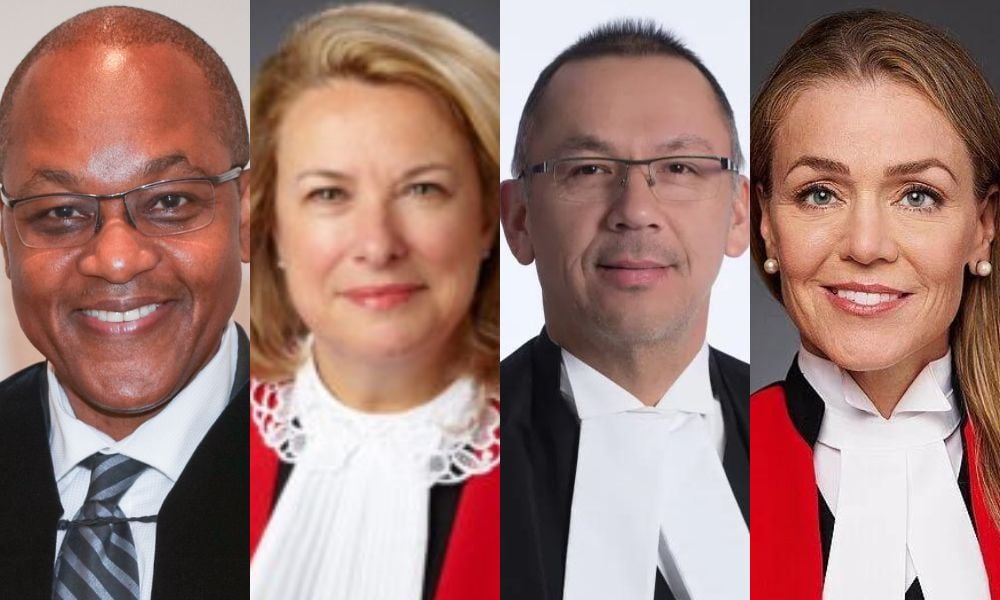Ideas given on how to improve trust especially among Indigenous and racialized groups

The centralization of court services in Toronto has been good for efficiency and economies of scale, Ontario Chief Justice Michael Tulloch told attendees at a recent conference. Still, it has impacted “front-line” staff put into the position of taking longer to get to work.
On the one hand, he said at a Canadian Bar Association forum on June 21 on the roles of journalists and the judiciary in preserving public trust in the justice system, centralizing services has modernized the courts. “A lot of the suburban courts were in much older buildings,” Chief Justice Tulloch said, while some were in strip malls and temporary locations, often paying a fair amount in rent.
However, depending on their job classification and salary, front-line staff may have a more difficult and expensive time getting to their jobs. For example, when working in suburban areas, many could at least “find parking or access their employment easily,” he said. Centralizing these services in central Toronto, “perhaps one of the most expensive cities in Canada, creates added stress and economic strain,” making it a more time-consuming and expensive challenge to get to work.
Combine this with pay scales at the lower end of the system, many front-line workers in the court system have looked for jobs elsewhere outside of the courts, he said.
As well, “it’s hard for us to hire people to do the job that’s needed to be done because of the lack of resources and the lack of compensation . . . required in a very expensive urban area.” In Chief Justice Tulloch’s view, this “directly impacts access to justice” if it results in closures of courthouses or courtrooms.
“This is a direct result of the lack of resources we’re facing,” he added. “That’s something that I think is of concern, and it should be of concern to the government.”
Another issue at the forum was the growing number of people representing themselves in the legal system and the impact that has on access to justice.
Michèle Monast, President of the Canadian Superior Court Judges Association and a superior court judge in Quebec, noted that dealing with self-represented parties can impact the court system's finances and administration.
A judge who presides at a trial or hears a motion involving self-represented litigants needs to gain the trust of the people in front of them and help them with any potential lack of knowledge of the law, Justice Monast said.
“We have to assist them without breaking this delicate balance,” she noted, explaining to self-represented parties how the court functions without favouring the side that has a lawyer.
“We have to explain that we’re there to assist in guiding them through the process, to tell them when they will have an opportunity to speak,” Justice Monast told attendees. Still, "we’re not their attorney, and we have to assume it’s their choice to represent themselves.” However, “we all must realize that dealing with self-represented litigants is something that is getting more and more difficult because of the lack of resources.”
Paul Favel, a judge with the Federal Court of Canada who comes from the Poundmaker Indigenous community in Saskatchewan, told those attending the conference that the court system comes with a fair amount of “formality and structure,” a system that has been around for centuries. However, for Indigenous communities that may be in remote areas, this formality and structure can be difficult and unsettling.
Added to that is the stress and anxiety that Indigenous people come to court because their communities have had “less than positive treatment” in the legal system. “Perhaps it doesn’t feel so safe for people in remote communities or who are Indigenous” in these court settings, Justice Favel said.
However, Justice Favel noted that there has been more recognition by the judiciary and governments of the need to make Indigenous people dealing with the court system more comfortable. One example is in British Columbia, where Indigenous sentencing courts assist offenders who have acknowledged responsibility for their actions to embark on a healing journey involving the victim and community support workers.
“It’s not the same typical courtroom structure,” he said, explaining that it may involve traditional ceremonies and the support of elders. Other setups to accommodate Indigenous culture can include everyone sitting on the same level, not a setup where judges sit up higher.
These examples illustrate that there has been a recognition that, in the past, the judicial system has not been very accommodating or comfortable for Indigenous people involved with the judicial system, and attempts are being made to change that, Justice Favel said. “These initiatives are welcome, but additional work still needs to be done.”
Marie-Anne Paquette, Chief Justice of the Superior Court of Quebec, says that building trust with those who become entangled with the legal system depends on how well it can accommodate those who encounter it.
However, she pointed out that “you cannot build trust” in a system stretched for resources. “If you want to build trust with people or groups [who have had] negative experiences or perceptions of what the justice system can bring to them, then the justice system and the judges and all the people involved have to be on their best behaviour.
“If on the day preceding a trial or on the day of the trial, we are unable to proceed because there’s a shortage of judges or someone overlooked the necessity of making sure there would be a courtroom, then we’re not on our best behaviour.” And a shortage of resources can only make building trust more difficult.
Ontario Chief Justice Michael Tulloch pointed out that there is also a significant level of discomfort among racialized individuals when it comes to the legal system, especially the criminal justice system, which he explained includes both the police system and the court system.
“We have to look at them together,” he said, noting a disproportionate number of people in the criminal justice system are incarcerated. The media’s “disproportionate” coverage of “also informs the public narrative.”
“Racialized people . . . are also reading the media,” he said. “They’re watching television and all sorts of other multimedia sources, which informs their perception of the entire system.”
To change that negative perception, “we have to work collaboratively,” Chief Justice Tulloch said, pointing to a suggestion in a previous panel that there be some sort of “boot camp” to educate the media and give members of news organizations information that makes them “cognizant of some of these issues that actually adversely impact the confidence in the public trust in our administration of justice.”










